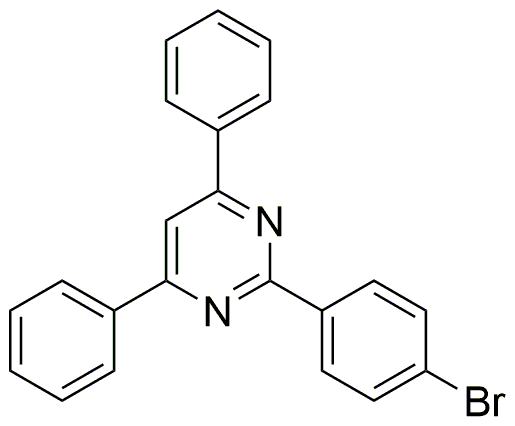2-(4-Bromophenyl)-4,6-diphenylpyrimidine is widely utilized in research focused on:
- Pharmaceutical Development: This compound serves as a key intermediate in the synthesis of various pharmaceuticals, particularly in the development of anti-cancer agents, due to its ability to inhibit specific cellular pathways.
- Material Science: It is employed in the creation of advanced materials, such as organic light-emitting diodes (OLEDs), where its unique electronic properties enhance device performance.
- Agricultural Chemistry: The compound is investigated for its potential use in agrochemicals, helping to develop new pesticides that are more effective and environmentally friendly.
- Biochemical Research: Researchers utilize it to study enzyme interactions and cellular mechanisms, providing insights into disease processes and potential therapeutic targets.
- Analytical Chemistry: It is used as a reference standard in various analytical methods, ensuring accuracy and reliability in the detection of related compounds in complex mixtures.
General Information
Properties
Safety and Regulations
Applications
2-(4-Bromophenyl)-4,6-diphenylpyrimidine is widely utilized in research focused on:
- Pharmaceutical Development: This compound serves as a key intermediate in the synthesis of various pharmaceuticals, particularly in the development of anti-cancer agents, due to its ability to inhibit specific cellular pathways.
- Material Science: It is employed in the creation of advanced materials, such as organic light-emitting diodes (OLEDs), where its unique electronic properties enhance device performance.
- Agricultural Chemistry: The compound is investigated for its potential use in agrochemicals, helping to develop new pesticides that are more effective and environmentally friendly.
- Biochemical Research: Researchers utilize it to study enzyme interactions and cellular mechanisms, providing insights into disease processes and potential therapeutic targets.
- Analytical Chemistry: It is used as a reference standard in various analytical methods, ensuring accuracy and reliability in the detection of related compounds in complex mixtures.
Documents
Safety Data Sheets (SDS)
The SDS provides comprehensive safety information on handling, storage, and disposal of the product.
Product Specification (PS)
The PS provides a comprehensive breakdown of the product’s properties, including chemical composition, physical state, purity, and storage requirements. It also details acceptable quality ranges and the product's intended applications.
Certificates of Analysis (COA)
Search for Certificates of Analysis (COA) by entering the products Lot Number. Lot and Batch Numbers can be found on a product’s label following the words ‘Lot’ or ‘Batch’.
*Catalog Number
*Lot Number
Certificates Of Origin (COO)
This COO confirms the country where the product was manufactured, and also details the materials and components used in it and whether it is derived from natural, synthetic, or other specific sources. This certificate may be required for customs, trade, and regulatory compliance.
*Catalog Number
*Lot Number
Safety Data Sheets (SDS)
The SDS provides comprehensive safety information on handling, storage, and disposal of the product.
DownloadProduct Specification (PS)
The PS provides a comprehensive breakdown of the product’s properties, including chemical composition, physical state, purity, and storage requirements. It also details acceptable quality ranges and the product's intended applications.
DownloadCertificates of Analysis (COA)
Search for Certificates of Analysis (COA) by entering the products Lot Number. Lot and Batch Numbers can be found on a product’s label following the words ‘Lot’ or ‘Batch’.
*Catalog Number
*Lot Number
Certificates Of Origin (COO)
This COO confirms the country where the product was manufactured, and also details the materials and components used in it and whether it is derived from natural, synthetic, or other specific sources. This certificate may be required for customs, trade, and regulatory compliance.


